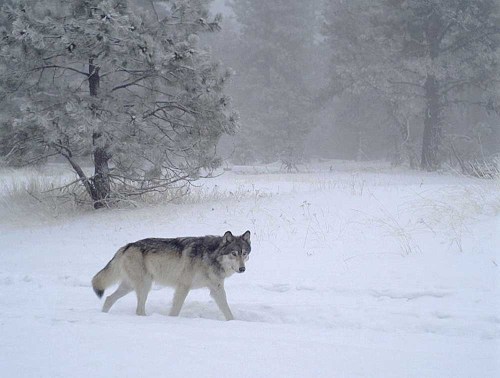Oregon Department of Fish and Wildlife to help eliminate wolf
Published 8:00 am Monday, June 13, 2022

- The breeding male of the new Chesnimnus Pack walks into camera view in December 2018 during the winter survey on U.S. Forest Service land in northern Wallowa County. Oregon Department of Fish and Wildlife officials on Friday, June 17, 2022, issued a second kill permit for Chesnimnus wolves.
CROW CREEK — State officials have agreed to help with the lethal removal of one Chesnimnus pack wolf after repeated attacks on livestock in Wallowa County, a spokesperson for the Oregon Department of Fish and Wildlife said Thursday, June 9.
Michelle Dennehy, of ODFW, said only one wolf has so far been taken under a kill permit issued April 29 and extended to June 14. That permit was for two wolves and an agent of Crow Creek rancher Tom Birkmaier shot one wolf in May.
Trending
The permit allowed Birkmaier or his agent to kill two wolves in Dorrance Pasture or Trap Canyon Pasture, where recent depredations on cattle occurred, he said when the permit was issued. Dennehy said since one wolf has been taken, the permit is good for one more. The ODFW website stated it would be updated if another wolf is killed or the permit is reissued.
At the time, Birkmaier asked ODFW to “remove” — or completely kill — the Chesnimnus pack given its propensity toward predatory behavior, but the agency just issued the kill permits.
John Williams, co-chairman of the wolf committee Oregon Cattlemen’s Association, said ranchers are busy enough and shouldn’t have to do what he considered the ODFW’s job of managing the wolves.
“When there’s a time to kill wolves, they’re the ones who should be doing it,” Williams said last month of ODFW.
The minimum known count of wolves in Oregon at the end of 2021 was 175 wolves, an increase of two wolves over the 2020 number, according to the Oregon Wolf Conservation and Management 2021 Annual Report released April 19.
According to a May 24 report in The Oregonian, one wolf that had been part of the Chesnimnus pack and found dead Jan. 8 southeast of Wallowa originally was determined to have been killed by a gunshot wound, Oregon State Police said at the time. But the U.S. Fish and Wildlife Service Forensics Laboratory in Ashland conducted an analysis that showed the wolf actually died of blunt-force trauma to the chest and pelvis. State police said and those injuries were consistent with being hit by a car.
Trending
Nonlethal efforts tried
Birkmaier has been known for his efforts to use nonlethal deterrents to keep wolves at bay.
“He’s doing every nonlethal (action) everybody can dream up,” Williams said. “What was more effective was he had a lot of people out there helping with nonlethal presence of humans.”
“I’m still continuing the relentless nonlethal measures, including two AM-FM radios, two fox lights that come on at night and motion-triggered noise-making devices that have a siren and flashing lights,” Birkmaier said. “I’ve been putting those in saddles on ridges or any natural crossing area where wolves may enter pasture.”
Dennehy confirmed “the producer” has been attempting to use nonlethal methods of deterring wolf attacks with limited success.
More livestock deaths
ODFW in its ongoing Wolf Depredation Report on June 8 reported one more confirmed and one probable wolf kills of livestock in Wallowa County.
The two were attributed to the Chesnimnus pack, one a 225-pound, 4-month-old calf in the Chesnimnus Creek area June 4 and the other a 245-pound, 2½-month-old calf in the Crow Creek area the same day.
Another three kills were confirmed June 6 in the Daly Creek area of Baker County. They were attributed to the Lookout Mountain pack, ODFW reported.
The Chesnimnus pack has been reported to have killed numerous livestock in Wallowa County this year.
The report lists five confirmed or probable wolf kills of livestock in Wallowa County and two others designated “possible/other” since early May. In that time, another 18 confirmed/probable and 10 possible/other kills are listed in the report for neighboring counties. The livestock deaths, while mostly cattle, also include sheep, goats, working dogs and at least one horse, according to the ODFW.









